Multilevel Coding for the Full-Duplex Decode-Compress-Forward Relay Channel
Abstract
:1. Introduction
2. Preliminaries
2.1. The Relay Channel
2.2. Multilevel Coding
3. Decode-Compress-Forward
3.1. Discrete Memoryless Full-Duplex Relay
3.2. AWGN Full-Duplex Relay
3.3. Constellation-Constrained Full-Duplex Relay
4. Multilevel Decode-Compress-Forward
- The optimal function of each level (being a DF or a CF level) at the source and the relay depends on the constellation and the channel conditions. Using an exhaustive search to opti ize (39), one can find the best set of levels for decode-forward and for compress-forward at the source and the relay.
- The number of bits of and depends on the rate of the decode-forward and compress-forward components given byandrespectively.
5. Simulations
6. Conclusions
Acknowledgments
Author Contributions
Conflicts of Interest
References
- Van Der Meulen, E.C. Three-terminal communication channels. Adv. Appl. Probab. 1971, 3, 120–154. [Google Scholar] [CrossRef]
- Cover, T.; Gamal, A. Capacity theorems for the relay channel. IEEE Trans. Inf. Theory 1979, 25, 572–584. [Google Scholar] [CrossRef]
- Kramer, G.; Marić, I.; Yates, R.D. Cooperative communications. Found. Trends Netw. 2007, 1, 271–425. [Google Scholar] [CrossRef]
- Kramer, G.; Gastpar, M.; Gupta, P. Cooperative Strategies and Capacity Theorems for Relay Networks. IEEE Trans. Inf. Theory 2005, 51, 3037–3063. [Google Scholar] [CrossRef]
- Laneman, J.N. Cooperative Diversity in Wireless Networks: Algorithms and Architectures. Ph.D. Thesis, Massachusetts Institute of Technology, Cambridge, MA, USA, 2002. [Google Scholar]
- Lee, S.H.; Chung, S.Y. When is compress-and-forward optimal? In Proceedings of the Information Theory and Applications Workshop (ITA), San Diego, CA, USA, 31 January–5 February 2010; pp. 1–3. [Google Scholar]
- Bao, X.; Li, J. Efficient Message Relaying for Wireless User Cooperation: Decode-Amplify-Forward (DAF) and Hybrid DAF and Coded-Cooperation. IEEE Trans. Wirel. Commun. 2007, 6, 3975–3984. [Google Scholar] [CrossRef]
- Haghighat, J.; Hamouda, W. Decode-Compress-and-Forward with Selective-Cooperation for Relay Networks. IEEE Commun. Lett. 2012, 16, 378–381. [Google Scholar] [CrossRef]
- Chong, H.F.; Motani, M.; Garg, H.K. Generalized Backward Decoding Strategies for the Relay Channel. IEEE Trans. Inf. Theory 2007, 53, 394–401. [Google Scholar] [CrossRef]
- Imai, H.; Hirakawa, S. A new multilevel coding method using error-correcting codes. IEEE Trans. Inf. Theory 1977, 23, 371–377. [Google Scholar] [CrossRef]
- Wachsmann, U.; Fischer, R.F.H.; Huber, J. Multilevel codes: Theoretical concepts and practical design rules. IEEE Trans. Inf. Theory 1999, 45, 1361–1391. [Google Scholar] [CrossRef]
- Huber, J.; Wachsmann, U. Capacities of equivalent channels in multilevel coding schemes. Electron. Lett. 1994, 30, 557–558. [Google Scholar] [CrossRef]
- Huber, J.; Wachsmann, U. Design of multilevel codes. In Proceedings of the IEEE Information Theory Workshop (ITW), Rydzyna, Poland, 25–29 June 1995. [Google Scholar]
- Duan, L.; Rimoldi, B.; Urbanke, R. Approaching the AWGN channel capacity without active shaping. In Proceedings of the IEEE International Symposium on Information Theory ISIT, Ulm, Germany, 29 June–4 July 1997; p. 374. [Google Scholar]
- Lampe, L.H.J.; Fischer, R.F.H.; Schober, R. Multilevel coding for multiple-antenna transmission. IEEE Int. Symp. Inf. Theory 2002, 3, 203–208. [Google Scholar]
- Yeung, R. Multilevel diversity coding with distortion. IEEE Trans. Inf. Theory 1995, 41, 412–422. [Google Scholar] [CrossRef]
- Roche, J.; Yeung, R.; Hau, K.P. Symmetrical multilevel diversity coding. IEEE Trans. Inf. Theory 1997, 43, 1059–1064. [Google Scholar] [CrossRef]
- Mohajer, S.; Tian, C.; Diggavi, S. Asymmetric Multilevel Diversity Coding and Asymmetric Gaussian Multiple Descriptions. IEEE Trans. Inf. Theory 2010, 56, 4367–4387. [Google Scholar] [CrossRef]
- Jiang, J.; Marukala, N.; Liu, T. Symmetrical Multilevel Diversity Coding and Subset Entropy Inequalities. IEEE Trans. Inf. Theory 2014, 60, 84–103. [Google Scholar] [CrossRef]
- Abdel-Ghaffar, K.; Hassner, M. Multilevel error-control codes for data storage channels. IEEE Trans. Inf. Theory 1991, 37, 735–741. [Google Scholar] [CrossRef]
- Hern, B.; Narayanan, K. Multilevel Coding Schemes for Compute-and-Forward With Flexible Decoding. IEEE Trans. Inf. Theory 2013, 59, 7613–7631. [Google Scholar] [CrossRef]
- Chen, Z.; Xia, B.; Hu, Z.; Liu, H. Design and Analysis of Multi-Level Physical-Layer Network Coding for Gaussian Two-Way Relay Channels. IEEE Trans. Commun. 2014, 62, 1803–1817. [Google Scholar] [CrossRef]
- Morello, A.; Mignone, V. DVB-S2: The second generation standard for satellite broad-band services. Proc. IEEE 2006, 94, 210–227. [Google Scholar] [CrossRef]
- Blasco-Serrano, R. Coding Strategies for Compress-and-Forward Relaying. Ph.D. Thesis, Kungliga Tekniska Högskolan (KTH), Stockholm, Sweden, 2010. [Google Scholar]
- Blasco-Serrano, R.; Thobaben, R.; Rathi, V.; Skoglund, M. Polar codes for compress-and-forward in binary relay channels. In Proceedings of the Forty Fourth Asilomar Conference on Signals, Systems and Computers, Pacific Grove, CA, USA, 7–10 November 2010; pp. 1743–1747. [Google Scholar]
- Gamal, A.E.; Kim, Y. Network Information Theory; Cambridge University Press: Cambridge, UK, 2012. [Google Scholar]
- Duarte, M. Full-Duplex Wireless: Design, Implementation and Characterization. Ph.D. Thesis, Rice University, Houston, TX, USA, 2012. [Google Scholar]
- Shende, N.; Gurbuz, O.; Erkip, E. Half-duplex or full-duplex relaying: A capacity analysis under self-interference. In Proceedings of the 47th Annual Conference on Information Sciences and Systems (CISS), Baltimore, MD, USA, 20–22 March 2013; pp. 1–6. [Google Scholar]
- Ahmed, E.; Eltawil, A.M. All-Digital Self-Interference Cancellation Technique for Full-Duplex Systems. IEEE Trans. Wirel. Commun. 2015, 14, 3519–3532. [Google Scholar] [CrossRef]
- Alexandris, K.; Balatsoukas-Stimming, A.; Burg, A. Measurement-based characterization of residual self-interference on a full-duplex MIMO testbed. In Proceedings of the IEEE 8th Sensor Array and Multichannel Signal Processing Workshop (SAM), A Coruna, Spain, 22–25 June 2014; pp. 329–332. [Google Scholar]
- Mahmood, N.H.; Ansari, I.S.; Berardinelli, G.; Mogensen, P.; Qaraqe, K.A. Analysing self interference cancellation in full duplex radios. In Proceedings of the IEEE Wireless Communications and Networking Conference, Doha, Qatar, 3–6 April 2016; pp. 1–6. [Google Scholar]
- Ingber, A.; Feder, M. On the optimality of multilevel coding and multistage decoding. In Proceedings of the IEEE 25th Convention of Electrical and Electronics Engineers in Israel, Eilat, Israel, 3–5 December 2008; pp. 731–735. [Google Scholar]
- Mheich, Z.; Alberge, F.; Duhamel, P. Achievable rates optimization for broadcast channels using finite size constellations under transmission constraints. EURASIP J. Wirel. Commun. Netw. 2013, 2013, 1–15. [Google Scholar] [CrossRef] [Green Version]
- Abotabl, A.A.; Nosratinia, A. Broadcast Coded Modulation: Multilevel and Bit-Interleaved Construction. IEEE Trans. Commun. 2017, 65, 969–980. [Google Scholar] [CrossRef]
- Ungerboeck, G. Channel coding with multilevel/phase signals. IEEE Trans. Inf. Theory 1982, 28, 55–67. [Google Scholar] [CrossRef]
- Blahut, R. Computation of channel capacity and rate-distortion functions. IEEE Trans. Inf. Theory 1972, 18, 460–473. [Google Scholar] [CrossRef]
- Arimoto, S. An algorithm for computing the capacity of arbitrary discrete memoryless channels. IEEE Trans. Inf. Theory 1972, 18, 14–20. [Google Scholar] [CrossRef]


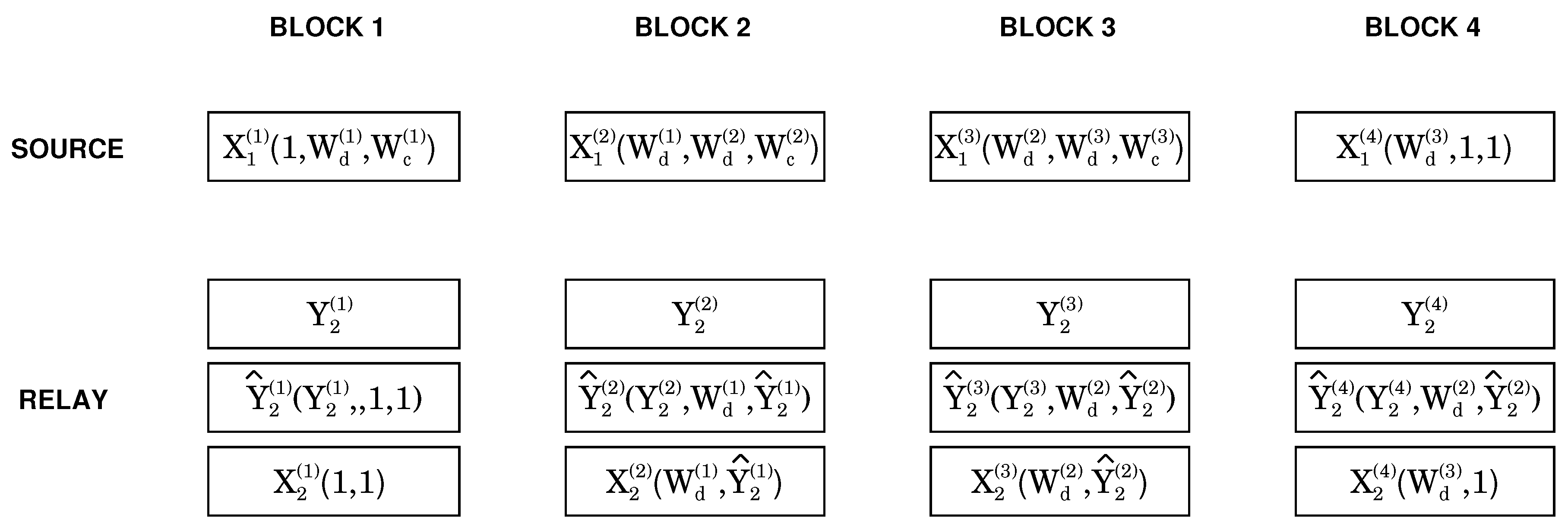

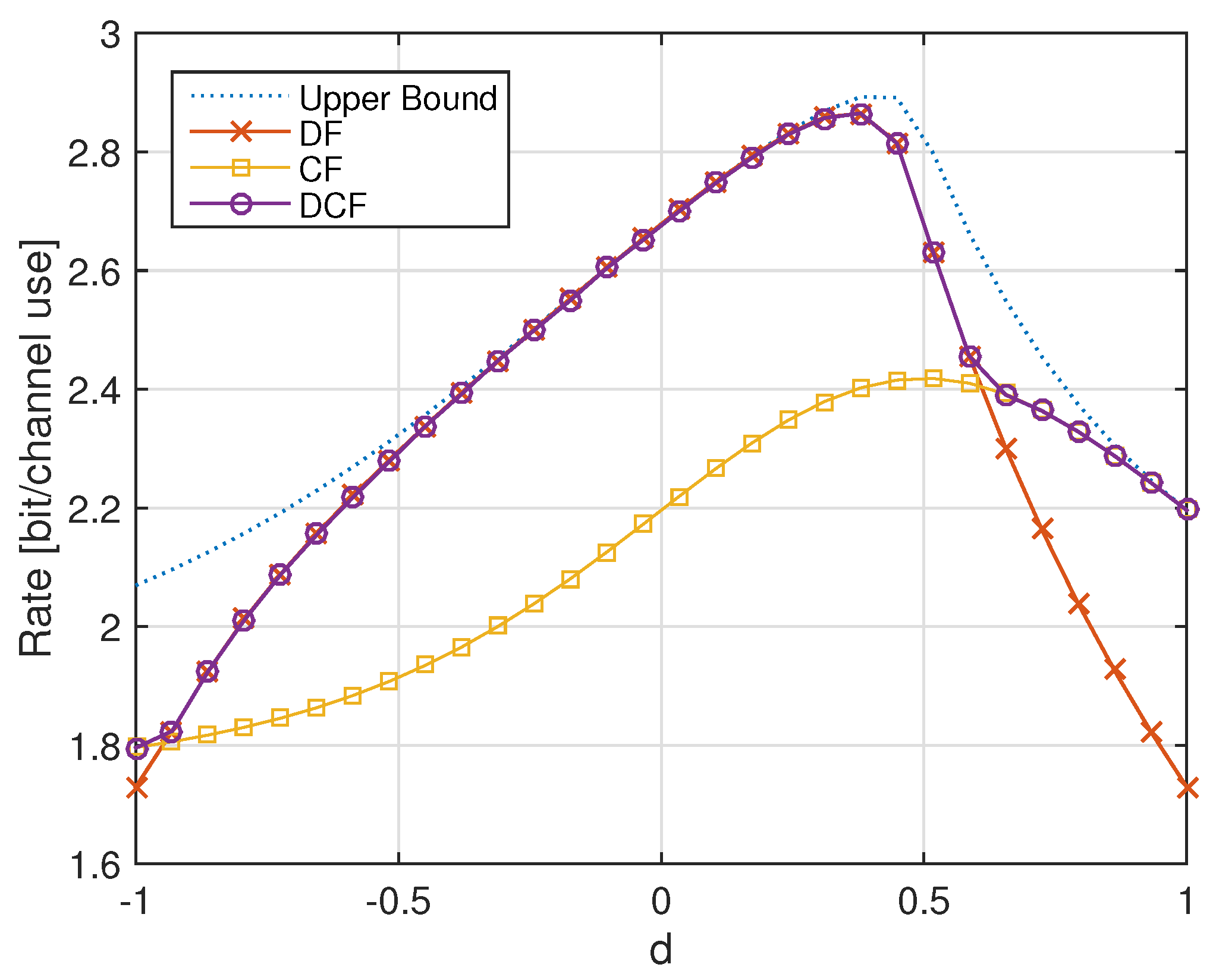
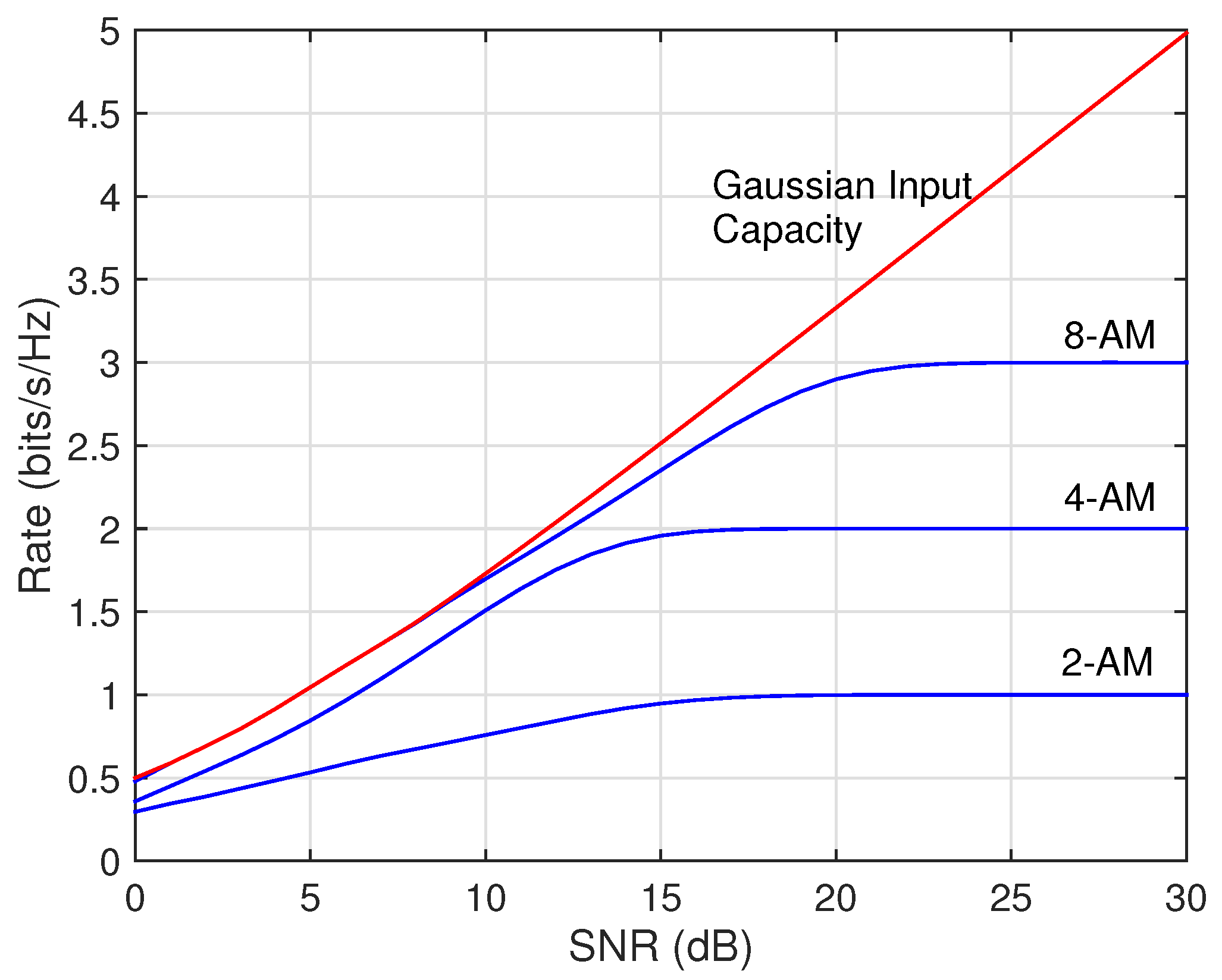


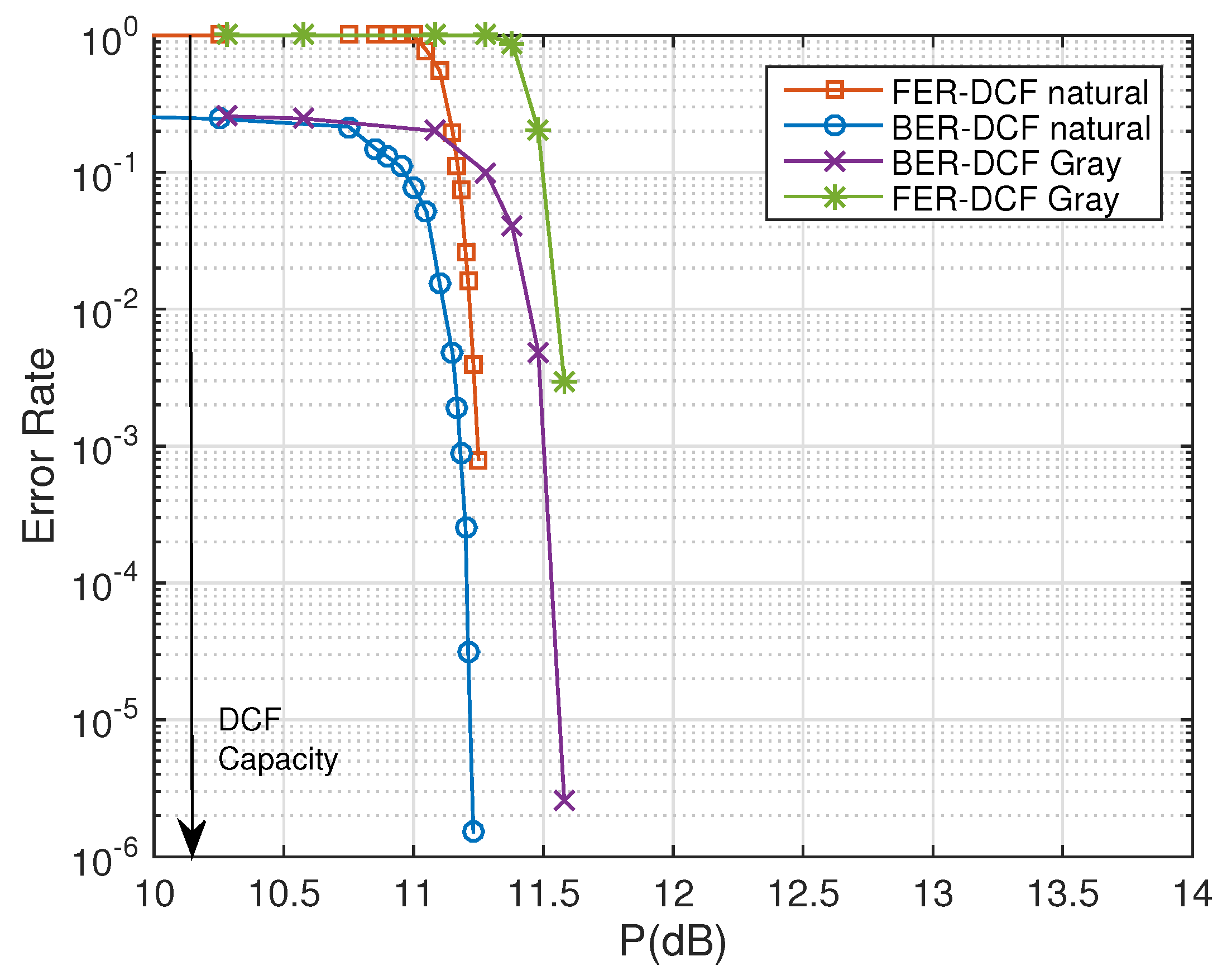
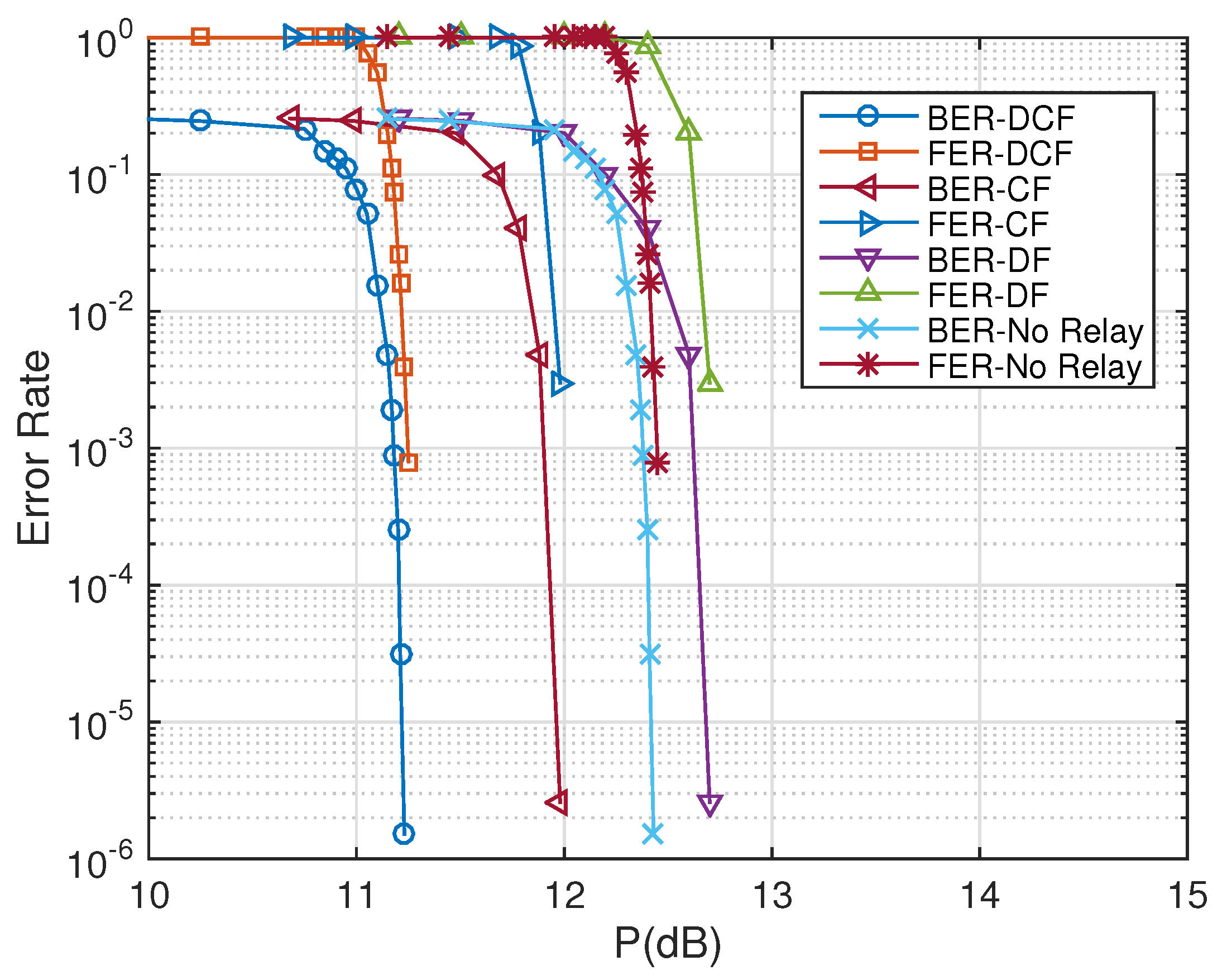
| Upper Bound | |||||||
|---|---|---|---|---|---|---|---|
| 1 | 100 | 1 | |||||
| 1 | 100 | 2 |
© 2017 by the authors. Licensee MDPI, Basel, Switzerland. This article is an open access article distributed under the terms and conditions of the Creative Commons Attribution (CC BY) license (http://creativecommons.org/licenses/by/4.0/).
Share and Cite
Abotabl, A.A.; Nosratinia, A. Multilevel Coding for the Full-Duplex Decode-Compress-Forward Relay Channel. Entropy 2017, 19, 611. https://doi.org/10.3390/e19110611
Abotabl AA, Nosratinia A. Multilevel Coding for the Full-Duplex Decode-Compress-Forward Relay Channel. Entropy. 2017; 19(11):611. https://doi.org/10.3390/e19110611
Chicago/Turabian StyleAbotabl, Ahmed Attia, and Aria Nosratinia. 2017. "Multilevel Coding for the Full-Duplex Decode-Compress-Forward Relay Channel" Entropy 19, no. 11: 611. https://doi.org/10.3390/e19110611




